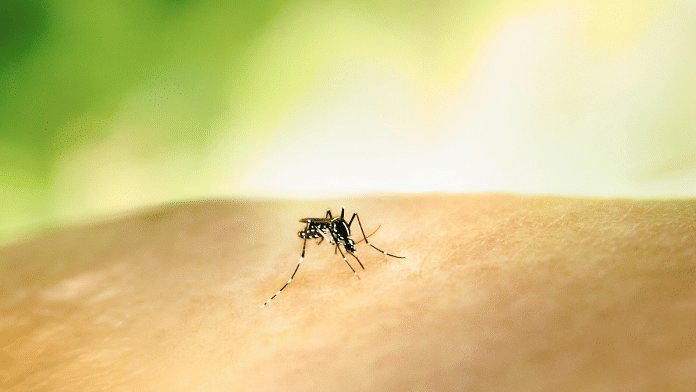
I n close-up, the black and white markings of Aedes albopictus are quite striking, but the ‘tiger mosquito’ can be deadly and is one of two insects behind the rapid rise of dengue fever across the globe. Since 2021, cases of dengue, also known as ‘break-bone fever’ due to the body aches it causes, have doubled each year. Between January and September 2024, there were more than 12.
7 million cases in total – almost double the 6.5 million cases reported in 2023 – as well as 8,791 deaths, according to the World Health Organization (WHO). The vast majority of cases were reported in the WHO’s Americas region, cases are now starting to climb in the Eastern Mediterranean and European regions – and the virus is now endemic in more than 130 countries.
In October, the WHO’s Director-General Tedros Adhanom Ghebreyesus warned the spread was “an alarming trend that demands a coordinated response across sectors and across borders”. It’s thought that more than 4 billion people, or around half the world’s population, are currently at risk from mosquito-borne infections , including dengue, Zika and chikungunya, which are known as arboviruses – and this is estimated to rise to 5 billion by 2050. Originally native to the tropical and subtropical climes of Southeast Asia, the tiger mosquito has spread worldwide as global temperature rise has enabled its habitat to expand.
The mosquito species is also highly adaptable, and its eggs can survive frost, allowing it to survive in colder climates, according to the UK government, tracking its spread into Europe . Dengue fever is cyclical, with large outbreaks tending to occur in areas with more mosquitoes , including both dengue-carrying Aedes albopictus and Aedes aegypti, every couple of years, according to the US Centers for Disease Control and Prevention (CDC). Dengue cases have also grown as urbanization (particularly unplanned) grows, bringing people further into mosquito habitats, and as people travel more internationally to places where it’s more common and then unwittingly spread the virus.
The Americas are at the epicentre of the current outbreak. The Pan American Health Organization (PAHO) reported on 31 October that cases in the year to date were up 209% compared to 2023 and up 387% compared to the average of the last five years. Brazil has reported the most cases, followed by Argentina, Mexico, Paraguay, and Colombia.
In Brazil, El Niño brought hotter, wetter weather for longer , creating optimal conditions for mosquitoes to breed and transmit well into winter 2023. And all four ‘serotypes’ or versions of dengue are circulating in Brazil for the first time, according to experts. The European Centre for Disease Prevention and Control has been tracking the virus in mainland Europe since 2010 – and the number of cases in France, Spain and Italy has more than doubled since last year .
In January 2024, the World Economic Forum published an insight report, Quantifying the Impact of Climate Change on Human Health , in collaboration with Oliver Wyman. It found that by 2050 climate change could contribute to an additional 14.5 million deaths and $12.
5 trillion in economic losses worldwide, with an additional $1.1 trillion in extra costs to healthcare systems. Tackling this global health challenge requires a comprehensive strategy that spans individual actions to international cooperation.
The WHO launched a global strategic plan in October 2024 to address dengue and other Aedes-borne arboviruses , which called for all stakeholders to join forces, as well as $55 million in funding to support health preparedness, readiness and response efforts. The six pillars of the WHO’s Global Arbovirus initiative. Image: WHO The Global Strategic Preparedness, Readiness and Response Plan SPRP outlines five key components for a successful outbreak response, from early detection to vaccine development: 1.
Emergency coordination: Establishing leadership and coordination activities. 2. Collaborative surveillance: Developing and using tools for early detection and control of dengue and other Aedes-borne outbreaks, including strengthened indicator and event-based surveillance, epidemiological analysis, laboratory diagnostics, and field investigations.
3. Community protection: Engaging communities through active dialogue and local adaptation of prevention and response measures, including mosquito population control. 4.
Safe and scalable care: Ensuring effective clinical management and resilient health services to ensure patients can receive adequate care and prevent illness and death. 5. Access to countermeasures: Promoting research and innovation for improved treatments and effective vaccines against these diseases.
The Forum’s report on the impact of climate change on human health highlights a crucial need for early warning systems, through reliable and rapid diagnostic tests in the case of dengue. As warmer temperatures and increased humidity encourage the growth and spread of mosquito populations, community data collection, accurate geographic information system forecasting and mosquito monitoring, can help indicate a future outbreak. These early warning systems trigger timely public health responses that can include larvae control, distribution of bed nets, diagnostic availability, and preventative and treatment therapeutics.
It can also pinpoint where to release male mosquitoes infected with a natural bacteria called Wolbachia , which limits their ability to transmit arboviruses. Other community-level interventions are vital in breaking the transmission cycle, including environmental management, proper waste disposal , and regular cleaning of water storage containers, which can significantly reduce mosquito breeding sites. Vaccination programmes are also beginning to show promise.
However, their implementation faces challenges, including the need for careful recipient screening to avoid potential complications in those without prior dengue exposure. The first dengue vaccine, Dengvaxia, was licensed in 2015 but requires a pre-vaccination screening test. Qdenga has been widely licensed based on phase 3 results showing a high level of efficacy in both previously uninfected (seronegative) and infected (seropositive) individuals, according to the WHO.
There is also another dengue vaccine in phase 3 development. For individuals, protection from mosquitoes by wearing appropriate clothing, using insect repellents and using mosquito nets in high-risk areas is important. The current dengue crisis serves as a stark reminder of our global interconnectedness and the shared vulnerabilities we face in an era of climate change and rapid urbanization.
It calls for a renewed commitment to public health, environmental stewardship, and international solidarity. Only through sustained, collaborative efforts can we turn the tide against dengue and build a more resilient global health system capable of responding to the challenges of our changing world. (The author, Shyam Bishen is the Head, Centre for Health and Healthcare; Member of the Executive Committee, World Economic Forum) This piece was first published in World Economic Forum.
Read the original article here . Also read: India sees alarming rise in dengue cases even before peak season, steady increase over past 4 years var ytflag = 0;var myListener = function() {document.removeEventListener('mousemove', myListener, false);lazyloadmyframes();};document.
addEventListener('mousemove', myListener, false);window.addEventListener('scroll', function() {if (ytflag == 0) {lazyloadmyframes();ytflag = 1;}});function lazyloadmyframes() {var ytv = document.getElementsByClassName("klazyiframe");for (var i = 0; i < ytv.
length; i++) {ytv[i].src = ytv[i].getAttribute('data-src');}} Save my name, email, and website in this browser for the next time I comment.
Δ document.getElementById( "ak_js_1" ).setAttribute( "value", ( new Date() ).
getTime() );.














